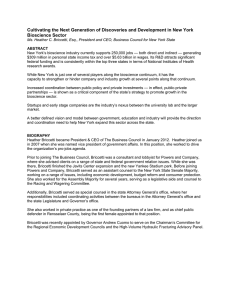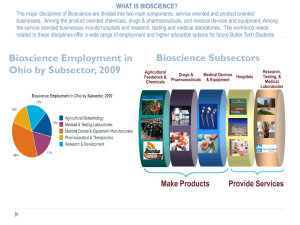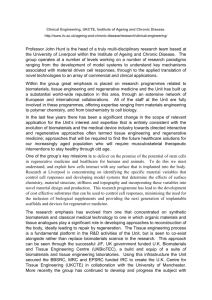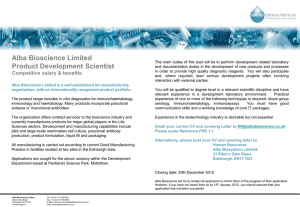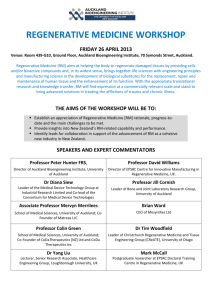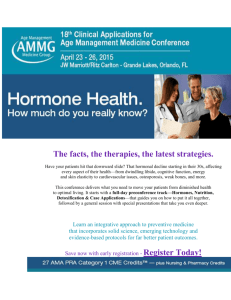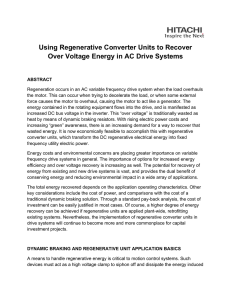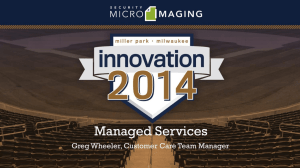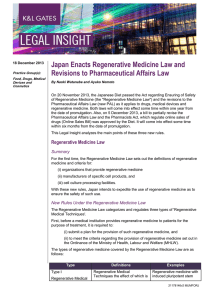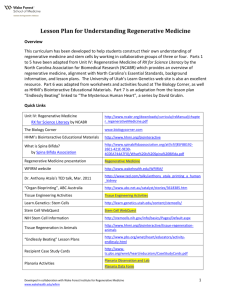Bioscience Immersion: Bringing Industry Into The Classroom
advertisement
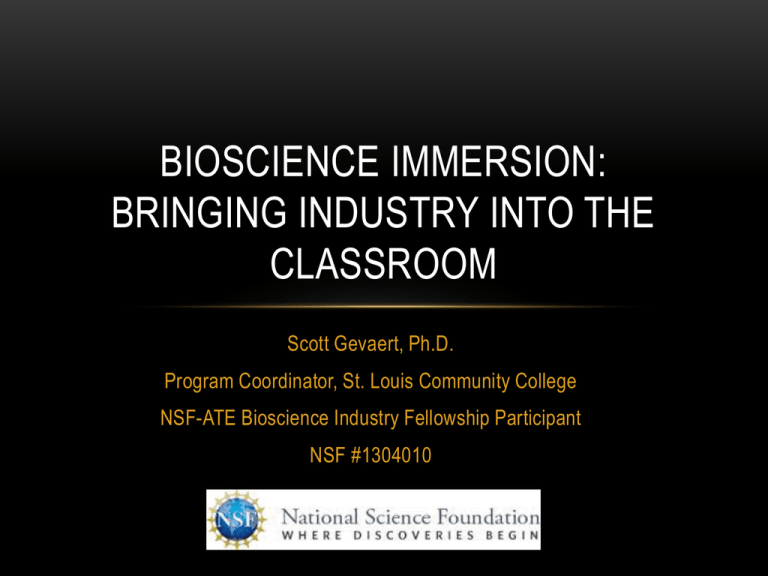
BIOSCIENCE IMMERSION: BRINGING INDUSTRY INTO THE CLASSROOM Scott Gevaert, Ph.D. Program Coordinator, St. Louis Community College NSF-ATE Bioscience Industry Fellowship Participant NSF #1304010 IMAGINE YOU ARE A DEVELOPMENTAL MATH INSTRUCTOR… • Your goal: • Learn how math is used in the biosciences to make the math you are teaching relevant • Your cohort: • 5 biology/biotechnology instructors • 1 computer science instructor • 1 physics instructor • 1 academic advisor • 1 USAF veteran and current student THE FIRST MORNING • Lab Safety • What is DNA? ONE HOUR LATER… HIGH PERFORMANCE LIQUID CHROMATOGRAPHY GAS CHROMATOGRAPHY/MASS SPECTROMETRY CELL CULTURE & BIOPROCESSING ANION EXCHANGE CHROMATOGRAPHY GOWNING & CLEAN ROOMS David Yarley and the three technicians who worked with us through anion exchange and gowning. Savitha Pinnepalli, BIFP Fellow YOU HAVE JUST FINISHED WEEK 2 NOW YOU START THE SECOND 2 WEEKS EDUCATIONAL INSTITUTE VISITS… • BRITE, North Carolina Central University • Food & Beverage Center, Asheville-Buncombe Tech, Asheville, NC • Joint School of Nanoscience & Nanotechnology AT BRITE, TOURS DEMONSTRATED… Automation Cell Membranes High Content Imaging Liver Cell Nuclei Lipid droplets FOOD, BEVERAGE, AND DIETARY SUPPLEMENTS AT A-B TECH • Use of U-V Spectrophotometry to identify the concentration of anthocyanins in different juices FOOD, BEVERAGE, AND DIETARY SUPPLEMENTS AT A-B TECH • Use of GC-MS to identify different oils within a solution JOINT SCHOOL OF NANOSCIENCE & NANOTECHNOLOGY • Microscopy • Genomics • Hydroponics • Brightener as nanoparticles added to plants for improved textiles INDUSTRY VISITS… Biomanufacturing & Pharmaceuticals Regenerative Medicine BIOGEN IDEC • A panel of workers throughout the company discussed worker qualifications • Variety of backgrounds: machine technicians, quality control, chemists • Importance of soft skills! TARGACEPT • Determined the next steps for getting a drug to market using information from the following areas • Efficacy • Safety • Quality • Value • Interacted with CEO, CFO, R&D Director, Quality Assurance Director REGENERATIVE MEDICINE AT WAKE FOREST INSTITUTE FOR REGENERATIVE MEDICINE • Regenerating Organs at different levels of complexity • Dept. of Defense research, helping injured solders • 3D Printing REGENERATIVE MEDICINE AT WAKE FOREST INSTITUTE FOR REGENERATIVE MEDICINE • Regenerating Organs at different levels of complexity • Level 1: Skin & Cartilage • Ear • Nose • Level 2: Tubular Systems • Esophagus • Level 3: Hollow Organs • Bladder Source: WFIRM REGENERATIVE MEDICINE AT WAKE FOREST INSTITUTE FOR REGENERATIVE MEDICINE • Dept. of Defense research: 3D Printing • Scan injured part of body • Use different cell types to regenerate the area needing repair SO HOW DO THESE EXPERIENCES ENTER OUR CLASSROOMS? • Aseptic technique without a cleanroom or biological safety cabinet • New curricula aligned to industry standards • Program modules for public use • Mathematical applications ASEPTIC TECHNIQUES NEW CURRICULA ALIGNED TO INDUSTRY STANDARDS • Using batch product reports • Using lab notebooks in proper technique • Students create Standard Operating Procedures (SOPs) and Batch Product Reports (BPRs) • Emphasize the importance of detailed work and accountability If you didn’t write it down, you didn’t do it! MODULE DEVELOPMENT • Concluding presentation using skills and industry visits • Be accessible publicly and applicable to any institution to use • Topics covered include: • Better K-12 training • Bridge high school students into a college program • Improved recruitment and communication methods • More interdisciplinary work: bioscience examples in developmental math In every math class you will hear … Why do I need to know this? When will I ever use this? In every science class you will hear … Did I learn how to do this in my math class? Slide courtesy of Heather King, BIFP Fellow 2014 Basic Mathematical Concepts Equations of Lines Proportions Percents Exponents Biotechnology Applications Basic Statistics Graphs Formulas Ratios Solving Equations Fractions Scientific Notation Conversions Slide courtesy of Heather King, BIFP Fellow 2014 Linear Equations in Two Variables Standard Curves & Unknown Concentrations Rowan Cabarrus Community College Absorbance (10, 0.59) (8, 0.51) (4, 0.31) (2, 0.24) Capsaicin mg/L • Use two data points to determine the equation for the line of best fit. Slope-Intercept Form of a Line y = mx + b • Use your equation to predict the amount of capsaicin present when the absorbance is 0.55. Slide courtesy of Heather King, BIFP Fellow 2014 FINAL COMMENTS FROM COLLEAGUES Heather King, Developmental Math Instructor, Forsyth Tech: “I enjoyed the hands on activities the most. These activities really helped me to learn what biotechnology was all about… I also enjoyed the tour of Biogen Idec. After this tour, I really understood the purpose of a bioreactor and a centrifuge.” Daymond Lindell, Academic Advisor, Forsyth Tech: On recommending bioscience as a career to students… “Try to imagine learning/teaching/working in a discipline or career where you can truly make a difference in the WORLD...now add to that a lucrative job market and exceptional pay! Would you be interested in that?” PROGRAM CONTACTS • Grant PI: Russell Read, rread@forsythtech.edu • Grant Co-PI: Denise Schweizer, denise.schweizer@rccc.edu • National Center for the Biotechnology Workforce, www.biotechworkforce.org • National Science Foundation, Advanced Technological Education SPECIAL THANKS… • My colleagues within the cohort • Mona Cofer, Mica Welsh, Russell Read, Amy Germuth, and Denise Schweizer (not pictured) • The National Science Foundation and Advanced Technological Education • The many people who taught us lab skills, took us on tours, open the doors of their company to help us understand the many different aspects of the bioscience industry QUESTIONS?
